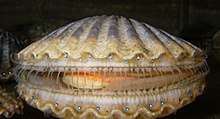Pteriomorphia
The Pteriomorphia comprise a subclass of saltwater clams, marine bivalve molluscs.[1] It contains several major orders, including the Arcida, Ostreida, Pectinida, Limida, Mytilida, and Pteriida. It also contains some extinct and probably basal families, such as the Evyanidae, Colpomyidae, Bakevelliidae, Cassianellidae, and Lithiotidae.
| Pteriomorphia | |
|---|---|
 | |
| A live individual of Argopecten irradians, family Pectinidae | |
| Scientific classification | |
| Kingdom: | Animalia |
| Phylum: | Mollusca |
| Class: | Bivalvia |
| Subclass: | Pteriomorphia Beurlen, 1944 |
This subclass of molluscs has lamellibranch gills, and is epibenthic. Some attach to the substrate using a byssus. The foot is reduced. The mantle margins are not fused. Gills are usually large and assist in feeding. This group includes the well known mussels, scallops, pen shells, and oysters.[2] It also includes the only members of the class bivalvia to have rudimentary eyes.
Phylogeny
The cladogram is based on molecular phylogeny using mitochondrial (12S, 16S) and nuclear (18S, 28S, and H3) gene markers by Yaron Malkowsky and Annette Klussmann-Kolb in 2012.[3]
| Pteriomorphia |
| ||||||||||||||||||||||||||||||||||||||||||
2010 Taxonomy
In 2010 a new proposed classification system for the Bivalvia was published by Bieler, Carter & Coan revising the classification of the Bivalvia, including the subclass Pteriomorphia.[4] However, the following taxonomy represents the current accepted arrangement of this subclass according to the World Register of Marine Species[5]
Subclass: Pteriomorphia
Order: Arcida[6]
(Ark shells and bittersweet shells)
- Superfamily: Arcoidea
- Family: Arcidae
- Family: Cucullaeidae
- Family: Glycymerididae
- Family: Noetiidae
- Family: Parallelodontidae
- Superfamily: Limopsoidea
- Family: Limopsidae
- Family: Philobryidae
Order: Ostreida[7]
(True oysters and their allies)
- Superfamily: Ostreoidea
- Family: Gryphaeidae, the foam oysters or honeycomb oysters
- Family: Ostreidae, the true oysters
Order: Pectinida[8]
(Scallops and their allies)
- Superfamily: Anomioidea
- Family: Anomiidae, the jingle shells and saddle oysters
- Family: Placunidae
- Superfamily: Plicatuloidea
- Family: Plicatulidae, the kittenpaws
- Superfamily: Dimyoidea
- Family: Dimyidae, the dimyarian oysters
- Superfamily: Pectinoidea
- Family: Entoliidae, the entoliids
- Family: Pectinidae, the scallops
- Family: Propeamussiidae, the mud scallops
- Family: Spondylidae, the thorny oysters
Order: Pteriida[11]
(Winged oysters and their allies)
- Superfamily: Pinnoidea
- Family: Pinnidae, the pen shells
- Superfamily: Pterioidea
- Family: Malleidae, the hammer oysters
- Family: Pteriidae, the feather oysters
- Family: Pulvinitidae, the pulvinitids
Fossil orders
- Cyrtodontida†
- Praecardiida†
References
- Pteriomorphia Beurlen, 1944. Retrieved through: World Register of Marine Species on 26 March 2009.
- Barnes, Robert D. (1982). Invertebrate Zoology. Philadelphia, PA: Holt-Saunders International. p. 430. ISBN 978-0-03-056747-6.
- Malkowsky, Yaron; Klussmann-Kolb, Annette (May 2012). "Phylogeny and spatio-temporal distribution of European Pectinidae (Mollusca: Bivalvia)" (PDF). Systematics and Biodiversity. 10 (2): 233–242. doi:10.1080/14772000.2012.676572.
- Bieler, R., Carter, J.G. & Coan, E.V. (2010) Classification of Bivalve families. Pp. 113-133, in: Bouchet, P. & Rocroi, J.P. (2010), Nomenclator of Bivalve Families. Malacologia 52(2): 1-184
- Gofas, S. (2014). "Pteriomorphia". World Register of Marine Species. Retrieved 2014-08-19.
- Arcoida Stoliczka, 1871. Retrieved through: World Register of Marine Species on 3 February 2009.
- Ostreoida Ferussac, 1822. Retrieved through: World Register of Marine Species on 9 July 2010.
- Pectinoida Gray, 1854. Retrieved through: World Register of Marine Species on 9 July 2010.
- Limoida Moore, 1952. Retrieved through: World Register of Marine Species on 7 July 2010.
- Mytiloida Ferussac, 1822. Retrieved through: World Register of Marine Species on 9 July 2010.
- Pterioida Newell, 1965. Retrieved through: World Register of Marine Species on 9 July 2010.
| Wikispecies has information related to Pteriomorphia |